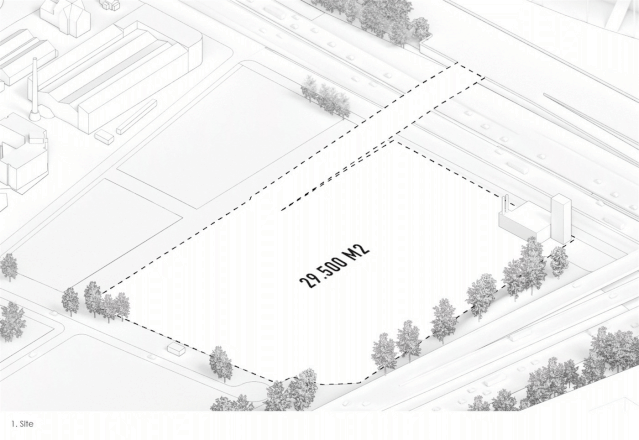查看完整案例


收藏

下载
在奥运“标志性”场馆越来越昂贵的趋势下,这些场馆给城市带来了极大的负担。相比之下,MVRDV为2024年巴黎奥运会设计的水上中心是一种令人耳目一新的解决方案。该方案以奥运场馆所在区域的需求为出发点,旨在改善邻近区域之间的联系,创造城市内部的垂直公园和“绿肺”,同时融入周围环境。
MVRDV’s proposal for the Aquatic Centre at the 2024 Paris Olympic Games is envisioned as a refreshing antidote to the trend for self-consciously “iconic” Olympic venues that subsequently become expensive, oversized burdens upon their cities. MVRDV’s design, by contrast, takes as its starting point the needs of the area, improving connections between neighbouring locations and creating a vertical park and “green lung” within the city while assimilating itself into its surroundings.
图/Image:
© Engram
MVRDV设计的巴黎奥运会水上中心旨在改善邻近区域之间的联系,创造城市内部的垂直公园和“绿肺”,同时融入周围环境
MVRDV's proposal aim to improve the connections between neighbouring locations and create a vertical park and “green lung” within the city while assimilate itself into its surroundings.
巴黎奥运水上中心位于巴黎郊区圣德尼,与其东面的法兰西体育场隔公路相望。水上中心附近并不缺乏标志性建筑。但是基地所在社区的行人连接、绿色空间和便利设施亟待改善,这一点对于地块西边Plaine Saulnier共同开发区的居民尤为重要。
Located in the Parisian suburb of Saint-Denis, separated from the Stade de France by a highway on its eastern boundary, the location of the Aquatic Centre is not lacking in iconic structures. Instead, it is in desperate need of improved pedestrian connections, green space, and amenities for the neighbourhood – in particular, for the residents of the concerted development zone (ZAC) of Plaine Saulnier, located to the west of the site.
图/Image: © Engram
水上中心并未与法兰西体育场争夺人们的注意力,它基本上是一个包含了运动空间的简单矩形
Rather than competing with the stadium for attention, the shape of the Aquatics Centre is essentially a simple rectangle with spaces for sport
该方案包括一条宽阔的大道和一座连接 Plaine Saulnier共同开发区和法兰西体育场的人行天桥,满足了社区的需求。水上中心并未与法兰西体育场争夺人们的注意力,它基本上是一个包含了运动空间的简单矩形。可以容纳6000人的奥运会游泳池和跳水池位于场馆中央,四周设置了室内攀岩区,健身冥想区、儿童游乐水池、共享办公空间和一个餐馆。这种温和的方式在建筑的表皮延续,建筑的外部表面——立面、屋顶和铺装——都将采用浅色低碳混凝土。充满柔和曲线的建筑好像被布满绿植的街道覆盖,使建筑和周围环境融为一体。
The proposal provides for these needs, with a broad avenue and a pedestrian bridge connecting the ZAC Plaine Saulnier to the Stade de France. Rather than competing with the stadium for attention, the shape of the Aquatics Centre is essentially a simple rectangle, with spaces for sport – including an indoor climbing area, fitness and meditation zones, a splash pad for children, coworking spaces, and a restaurant – arranged around the central space holding Olympic swimming and diving pools, with seating for up to 6000 spectators. Continuing this modest approach, the exterior surfaces – façade, roof, and paving – are all finished in a light-coloured low-carbon concrete, with gently curving edges giving the impression of a continuous sheet that has been “draped” over the new addition, blending the building with its surroundings.
图/Image:
© Engram
椭圆形的窗户和天窗为泳池提供了良好的采光,减少了能源消耗
Oval windows and skylights provide excellent daylighting for the pools, reducing energy consumption
建筑的标志性特征是屋顶上大面积的绿色植被。在西立面,通过一系列穿过灌木和草地向上延伸的小径和台阶,建筑逐渐从地面升起。这些小径和台阶为行人提供了通往户外休闲空间、一楼餐厅露台和攀爬墙面的通道。这个垂直公园和它的便利设施使面向Plaine Saulnier共同开发区的立面充满活力,为周围社区增加了可见而生动的公共空间。
The building’s signature feature is the explosion of greenery covering its roof. On its western façade, too, the building gradually rises from the floor, with a series of paths and steps leading upwards through shrubs and grasses, providing pedestrians access to outdoor leisure spaces, the first-floor restaurant terrace, and a climbing wall. This vertical park and its amenities animates the façade facing the ZAC Plaine Saulnier, adding a visible and lively piece of public space for the neighbourhood.
图/Image:
© Engram
西立面一系列穿过灌木和草地向上延伸的小径和台阶,为行人提供了通往户外休闲空间、一楼餐厅露台和攀爬墙面的通道
With a series of paths and steps leading upwards through shrubs and grasses, the west facade provides pedestrians access to outdoor leisure spaces, the first-floor restaurant terrace, and a climbing wall
屋顶也被绿色植被覆盖,小草和灌木种植在屋顶的中心,最高可达2米的大型植物则栽植在屋顶边缘,因为那里的结构可以容纳更深的土壤层。建筑边缘,屋顶向下倾斜,向行人们展示了绿色景观,从屋顶垂吊下来的绿色植物增强了人们对自然景观多样性的印象。
The roof is also covered in greenery, with smaller grasses and shrubs covering the centre of the roof and larger plants up to 2 metres tall closer to the roof’s edges, where the structure can support a deeper soil layer. At its very edges, the roof slopes downwards. These sloped edges reveal this green landscape to passers-by, with hanging plants at the very edges of the roof only adding to the impression of the diverse natural landscape behind.
图/Image:
© Engram
在可持续发展方面,这一大片植物为该社区带来了实质性的好处,城市中超过一公顷的“绿肺”可以改善空气质量,降低当地温度。与西立面不同,屋顶不对游客开放,这使得它不仅具有植物多样性,同时也能促成动物多样性。室内,椭圆形的窗户和天窗为泳池提供了良好的采光,减少了能源消耗。同时,建筑在减少池水消耗方面也做出了许多努力,通过和Engie合作,该建筑使用的80%的能源将来自可持续能源。
This expanse of plants offers substantial benefit to the area in terms of sustainability, with this “green lung” of over one hectare within the city helping to improve air quality and lower local temperatures. Unlike the western façade, the roof itself is not accessible to visitors, making it a perfect attraction not only for plant biodiversity, but for animal biodiversity as well. Inside, oval windows and skylights provide excellent daylighting for the pools, reducing energy consumption, while significant effort was made to reduce the water consumption in the pools themselves. Thanks to the partnership with Engie, 80% of the energy used by the building would come from sustainable sources.
图/Image: © MVRDV
在设计过程中,为了保证方案的可行性并控制成本,MVRDV对技术给予了很大的关注。虽然最初的概念方案包括一个公共可达的起伏屋顶,但后来结构被优化,因此方案保持了最初的目标,即创造一个都市化的、可持续的、功能性的、绿色的、社会化的奥林匹克水上运动中心,同时造价不超出预算。
During the design process, much attention was given to technical aspects of the project in order to ensure the feasibility and affordability of the proposal. While the initial concept proposal included a publicly accessible, undulating roof, the structure was later rationalised so that the design maintained the original aim to develop an urban, sustainable, functional, green, and social Olympic Aquatic Centre while remaining comfortably within the proposed budget.
MVRDV建筑规划事务所由Winy Maas、Jacob van Rijs和Nathalie de Vries创立于荷兰鹿特丹,致力于为当代的建筑和都市问题提供解决方案。MVRDV的创作基于深度研究与高度协作,各领域的专家、客户及利益相关方从项目初期一直参与设计的全过程。直率而真诚的建筑、都市规划、研究和装置作品堪称典范,让城市和景观朝向更美好的未来发展。
MVRDV的早期项目,如荷兰公共广播公司VPRO的总部,以及荷兰阿姆斯特丹的WoZoCo老年公寓,都获得了广泛的国际赞誉。MVRDV250余位建筑师、设计师和城市规划师在多学科交叉的设计过程中,始终坚持严格的技术标准和创新性研究。MVRDV采用BIM技术,公司内拥有正式的BREEAM和LEED顾问。MVRDV与荷兰代尔夫特理工大学合作运营独立智库和研究机构The Why Factory,通过展望未来都市,为建筑及都市主义提供发展议程。
更多详细信息,请联系MVRDV亚洲公共关系部
+86 021 6288 0609 或
























